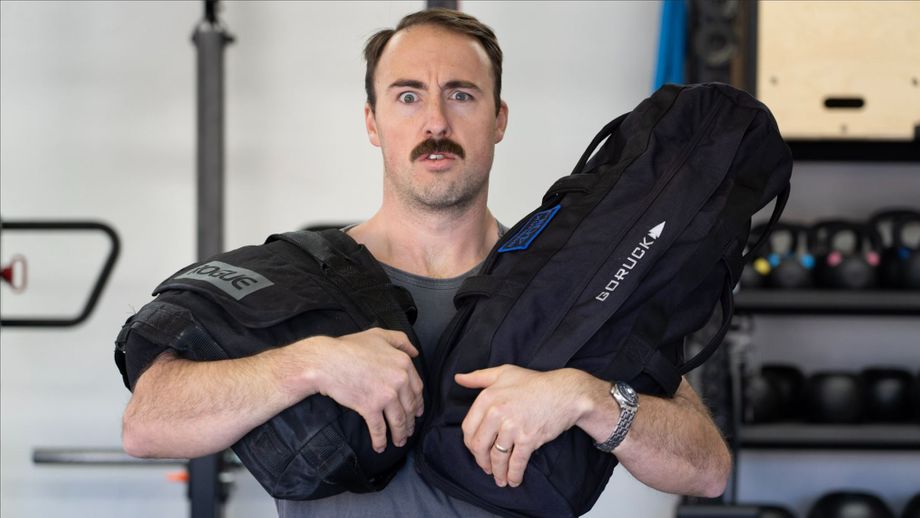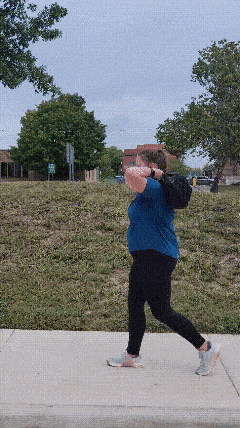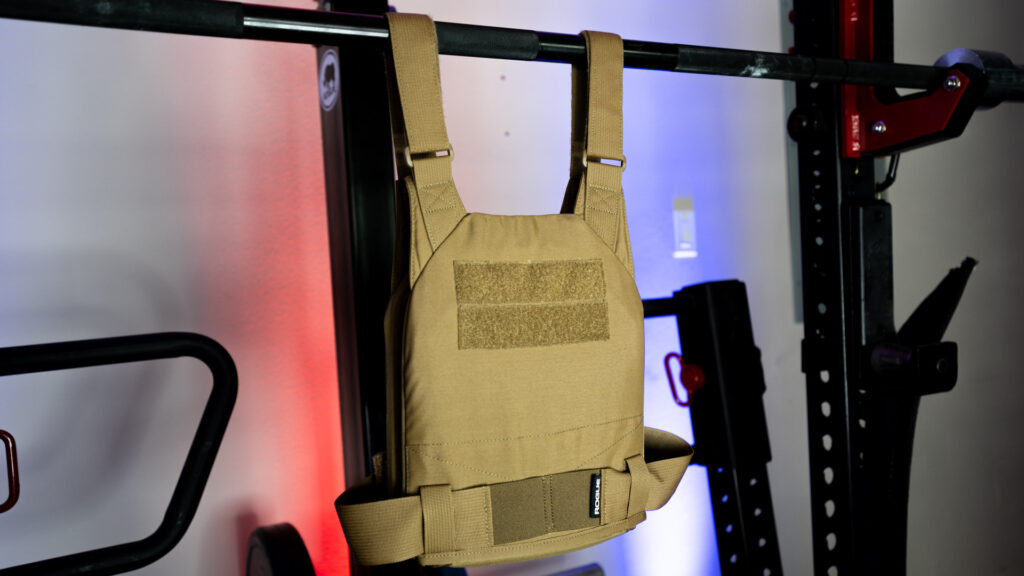We test and review fitness products based on an independent, multi-point methodology. If you use our links to purchase something, we may earn a commission. Read our disclosures.
Remember when you just couldn’t wait to take your backpack off as soon as you got home from school? The urge to get that weight off your shoulders as a kid is something you may soon experience again as an adult. And no, it’s not because you’re about to embark on a new educational journey well after your days as a student.
Ironically, those formative years of carrying around textbooks, notebooks, and whatever else you stuffed into your backpack were actually a covert training program designed to prepare you for a form of exercise that’s made waves in recent years: the ruck march.
Incredibly simple and highly effective, rucking combines elements of cardiovascular and strength training into a full-body workout that can help you build muscle, enhance your endurance, and improve your posture.
RELATED: Full-Body Workout At Home
As a certified personal trainer (CPT) and strength and conditioning specialist, I’m all for finding new ways to add variety to your fitness routine, and rucking workouts certainly offer an intriguing array of potential physical and mental health benefits.
To help you get off on the right foot (literally), I’ve put together a series of training sessions so ruckers of all shapes, sizes, and fitness levels can start becoming healthier one step at a time. Plus, we’ll have some additional insight from a longtime rugby player, certified EMT, and fire academy trainee who’s made rucking an integral part of his workout regimen.
What Is Rucking?
Before we dive into the workouts, let’s first get familiar with what rucking is. Luckily, there’s not much to it. In its most basic form, a rucking workout is just walking with added weight on your back.
Sounds easy, right?
While it doesn’t require a ton of equipment other than a weighted backpack, weighted vest, rucksack, or even a workout sandbag, don’t make the mistake of thinking you’re just going for a casual walk in the park. After all, there’s a reason rucking is an essential part of military training around the world—it provides mental and physical challenges that can help prepare soldiers for the demands of the job.

RELATED: Military Workout
According to GoRuck, United States Army candidates must complete a 12-mile ruck march within three hours to earn the Expert Infantryman Badge (EIB). Although the terrain is usually level, participants must carry at least 35 pounds, along with up to 100 pounds of gear and a rifle.
So, although it’s generally a safe, low-impact exercise, carrying a heavy load for a few miles will test your willpower as much as your cardio. If you’re rucking for functional fitness, weight loss, or another health-related goal, incorporating basic bodyweight exercises like squats, push-ups, and lunges can ramp up the challenge and provide additional muscle- and strength-building benefits.
RELATED: Benefits of Strength Training
Rucking Workouts for All Levels
If you’re ready to ruck, you’re in luck. As a CPT who’s tried everything from interval training to powerlifting to pool exercises, I understand not everyone is ready for the same level of intensity right away.
And that’s just fine.
These three workouts are just stepping stones in a longer rucking journey that could last for decades if you fall in love with this form of functional fitness. I designed each one based on experience and fitness level, giving you the ability to select the session that suits you best.
Beginners should focus on maintaining a steady pace and building their cardiovascular conditioning. Intermediate and advanced trainees can challenge themselves with longer distances, more weight, and additional en-route exercises.

Beginner Rucking Workout
This beginner-friendly rucking workout is as straightforward as it gets. Your goal should be to maintain a steady pace, grow comfortable with your stride length and width, and develop strength and stamina so you can eventually increase your distance and weight.
Beginner Rucking Workout
- Weight: 10 to 25 pounds
- Distance: 2 to 3 miles
- Instructions: Use a weighted backpack or rucksack with a light weight (around 10 pounds). Walk at a steady pace between 17 to 20 minutes per mile for 2 to 3 miles. If you’re unable to maintain 20 minutes per mile, lower the weight.
Intermediate Rucking Workout
As you progress with your rucking journey, you can add 5 pounds every couple of weeks—as long as increasing the weight doesn’t lead to poor posture. Once you’re at the intermediate stage, you can make your workouts more dynamic with additional exercises. Plus, you’ll also be working with a heavier weight (between 25 to 40 pounds).
Here’s a sample training session you can try. Feel free to swap out movements or add more if you want an additional challenge.
| Exercise | Reps/Time |
| Ruck March | 1.5 miles (between 15-17 minutes-per-mile) |
| Bodyweight Squat | 20 |
| Weighted Push-Up | 20 |
| Alternating Lunges | 20, per leg |
| Plank | 30 to 45 seconds |
| Ruck March | 1.5 miles (between 15-17 minutes-per-mile pace) |
Advanced Rucking Workout
You’ve graduated to the upper echelon of ruckers, so naturally, it’s time to kick things up a notch. For this workout, you’ll use a sandbag for a series of exercises and a weighted backpack or rucksack for the march. Challenge yourself to perform the circuit with minimal rest time, then use the march to bring your heart rate back down.
Advanced Rucking Workout
Instructions:
- Perform 10 reps of each exercise consecutively:
- Sandbag Squat
- Sandbag Overhead Press
- Sandbag Row
- Sandbag Thruster
- Then, put on your rucksack and ruck 2 miles at 15 minutes per mile.
- Repeat the circuit 2 to 3 times, depending on your fitness level.
Benefits of Rucking Workouts
From helping you become stronger and fitter to having a low cost of entry, rucking workouts offer plenty of upside. Here’s an overview of the benefits of this type of training, with some insight from Trent Theobald, an experienced athlete, certified EMT, and fire academy trainee who rucks routinely.
Provides a Full-Body Workout
Your upper body, core, and legs all have to work synergistically to get through a ruck march. Plus, you’ll get the benefits of cardio training as you make your way around your neighborhood or a nearby trail.
That bang-for-your-buck element is what first attracted Trent, a rugby player for the last 11 years, to rucking as a form of functional fitness.
“It’s a multi-purpose workout that focuses on both the mind and the body,” he explains. “You can achieve so much by manipulating the weight, duration, and speed to achieve the perfect intensity and get everything you need out of a single workout.”
Minimal Investment Required
Unlike powerlifting or some other specialized forms of fitness, rucking doesn’t require an expensive barbell and weight plates or an entire squat rack. That’s good news for your wallet. Weighted vests are reasonably priced, with something like the Rogue Plate Carrier checking in at around $130.

You can also go the DIY route and wrap a dumbbell in a towel and stick it in an old backpack to make your own “rucksack.” Other than supportive footwear, you really don’t need to invest in much else to get started.
RELATED: Best Cross-Training Shoes
For Trent (and many others), the low cost has led to a long-term commitment.
“I went to my local park or would walk around my neighborhood, so that was free and allowed me to meet other people,” he explains. “And the weight pack I got on Amazon for about $100, which isn’t bad at all when you consider how much use you’ll get out of it.”
Can Help Build Strength and Endurance
Rucking helps kill two birds with one stone, giving you the ability to work on your strength and cardio simultaneously. A loaded walk will test your hamstrings, quads, glutes, and calves, along with your core and upper-body muscles. Incorporating traditional strength training exercises like squat variations will give you an additional muscle-building boost.
Common Rucking Workout Mistakes
Rucking doesn’t involve many moving parts other than your feet. Yet, there are several ways this beneficial activity can quickly go south.
Here are some common mistakes to avoid, starting with your foundation:
Failing to Consider Your Footwear
Just like you wouldn’t wear the best running shoes to back squat, you shouldn’t wear just any shoe to ruck. Your feet need proper support, especially if you plan on going for long distances. GoRuck sells specialized rucking boots, or you could look into a supportive pair of trail running shoes.
Proper footwear is especially important given the stress placed on your ankles, feet, and lower extremities. A 2020 study1 on Army Reserve Officer Training Corps (ROTC) cadets found that ruck marching led to increased peak impact force and loading rate, which have been shown to be related to the risk of bone stress injuries.
RELATED: Best Trail Running Shoes
Poor Hydration Preparation
Failure to prepare is preparing to fail. One of the easiest ways to not set yourself up for a successful ruck march is forgetting about hydration.

Depending on the weather conditions, the weight you use, and your pace, you could lose a substantial amount of sweat and key nutrients. So, you should bring multiple bottles of water, along with your favorite electrolytes, to make sure you’re functioning optimally.
RELATED: Best Electrolyte Powder
Too Far, Too Heavy, or Too Fast (Too Soon)
Rome wasn’t built in a day. And even if you’re ready to rock your first ruck, I encourage you to keep that motto in mind.
As a CPT and longtime athlete, I understand it’s easy to want to go all-out right away. You wouldn’t try to curl a 50-pound dumbbell if you’ve never lifted weights before, so you shouldn’t try to knock out a 10-mile march with 50 pounds on your back right away.
There’s nothing wrong with starting at a conservative pace with moderate weight. In fact, that’s a better way to get your body accustomed to this new form of training than ramping your heart rate to the max by going too quickly or loading too many ruck plates than you can truly handle.
Rucking Workout: Final Thoughts
Rucking’s rise in popularity should serve as a reminder that it’s really just taking us back to our roots. Our ancestors didn’t have the luxury of cars, planes, or Amazon Prime to get what they wanted or get where they needed to be. Instead, they developed strong lower-back and core muscles and resiliency by carrying whatever they needed for long distances to survive.
Fast forward to modern times, and it’s clear we don’t live under the same life-or-death circumstances. However, we can give a tip of the cap to our predecessors (and service members) and take care of our bodies (and minds) by joining the #ruckmarch movement.
As much as we all love working out with a nicely knurled barbell or an extra-grippy kettlebell in the gym, there’s a sweet simplicity in strapping on a backpack or rucksack, putting on your favorite playlist, and just seeing where life takes you—one step at a time.
Rucking Workout: FAQs
How fast should you ruck?
According to GoRuck, the U.S. Army standard is 15 minutes per mile. However, you should train at a comfortable pace based on your fitness level, slowly increasing your speed over time.
Does rucking build muscle?
Yes, rucking can help build muscle as it is a form of resistance training. Just like lifting weights, you can use progressive overload principles, such as adding more weight to your rucksack or backpack, performing more repetitions of exercises, or going for longer distances.
How far should I ruck as a beginner?
Start with 2 miles if you’ve never rucked before. As you gain experience and increase your fitness, add another mile or two each week. You can also add weights in small increments (5 to 10 pounds) to increase the challenge.
References
- Earl-Boehm, J.E., Poel, D.N., Zalewski, K., Ebersole, K.T. (2020) The effects of military style ruck marching on lower extremity loading and muscular, physiological and perceived exertion in ROTC cadets. Ergonomics, 63(5):629-638. doi: 10.1080/00140139.2020.1745900. Epub 2020 Apr 2. PMID: 32191155.
Further reading

Sneakers, cross-trainers, and lifters alike, we gathered together our picks for the best gym shoes. Read more

A registered dietitian covers the formulation of Transparent Labs multivitamin and outlines if the quality matches the value for the price. Read more

Are you tired of cranking out crunches and slogging through sit-ups? Stand up, grab a dumbbell, and try out our dumbbell core workout instead! Read more

Remember when you just couldn’t wait to take your backpack off as soon as you got home from school? The urge to get that weight off your shoulders as a kid is something you may soon experience again as an adult. And no, it’s not because you’re about to embark on a new educational journey well after your days as a student.Ironically, those formative years of carrying around textbooks, notebooks, » Read more about: Load Up: Rucking Workouts for Beginners, Intermediate, and Advanced Trainees » Read more

